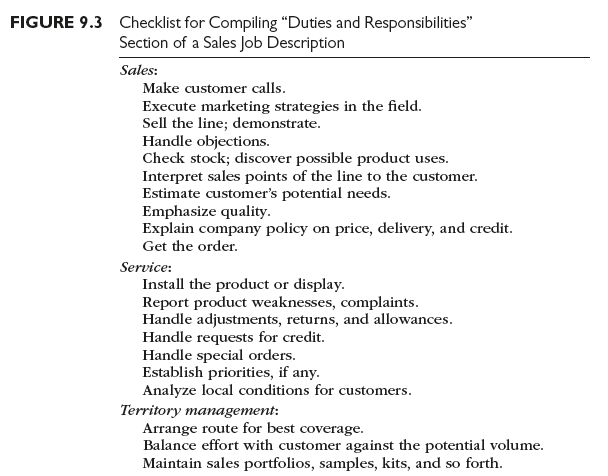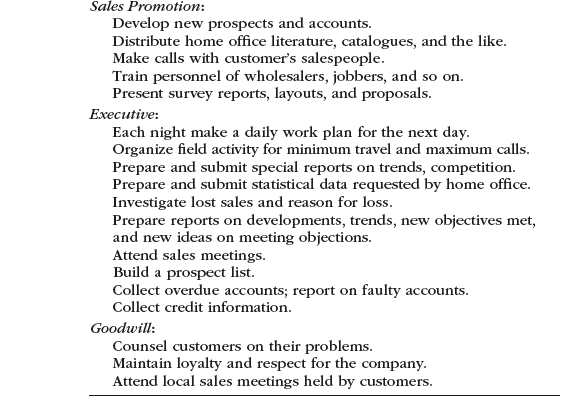Job analysis—assembling and analyzing factual information on specific jobs—is the basis for professional personnel management. Job analyses provide the data required for preparing written job descriptions, which, in turn, are used to derive job specifications (the qualifications and characteristics individuals need to perform given jobs). The job analysis, then, and its two derivatives, the job description and job specification, provide factual foundations for making decisions on hiring, transfers, promotion, training, and dismissals.
1. Sales Job Analysis
Sales job analysis is the critical first step in modern sales force management. The foundation for enlightened personnel management, sales job analysis has risen in importance since the Civil Rights Act brought pressure on sales executives to justify decisions on hiring, transfers, promotion, training, and dismissals. As a consequence, sales executives are concerned with making objective personnel decisions—basing decisions on facts, not upon hunches.
Sales job analysis requires systematic collection and study of information on particular sales jobs, such as that of territorial salesperson. It involves determining the job’s objectives and what the person holding the job should do to reach them. It answers such questions as: To whom does this person report? Who reports to this person? What products does this person sell? To whom does this person sell? What information should this person gather? What reports should this person make and to whom? Sales job analysis, in addition, elicits details on specific duties and responsibilities, relations with customers, relations with other sales department and company personnel, and the like. The outcome of a thorough analysis of a salesperson’s job is a detailed picture of the role(s) that the salesperson plays—as noted earlier (see Chapter 5), four basic selling styles cut, to a large degree, across industry and company boundaries: trade, missionary, technical, and new business. In analyzing the salesperson’s job in a particular company, in most cases, we find that the job combines two or more of these basic styles.
2. Sales Job Description
The key output of sales job analysis is the job description: A sales job description is an organized factual statement covering (1) the reporting relationship of a particular job to other jobs, (2) the job objectives, (3) duties and responsibilities, and (4) job performance criteria. A sales job description tells to whom the sales jobholder reports, what has to be done, how it is done, and why and, in addition, describes the standards against which performance is measured.
3. Procedure for Sales Job Analysis and Preparation of Written Job Descriptions
Procedures for sales job analysis and preparation of written job descriptions vary from company to company, but four main steps are identifiable in procedures used in well-managed companies: (1) assembly of factual information about the job, (2) analysis of the information, (3) writing of the job description, and (4) as required, repeat the process. A suggested procedure is
- Assemble factual information about the job:
- Clarify reporting relationships by questioning salespersons and those to whom they report.
- Prepare a questionnaire for sales personnel, asking them to list the job objectives, together with the major duties and what is involved in performing them, in doing the job effectively.
- Prior to receipt of the completed questionnaires, have sales executives and other executives interested in sales activities write down their conceptions of the salesperson’s job objectives, the salesperson’s responsibilities, and the duties they feel the salesperson should and should not perform.
- Survey customers to find out what they believe should and should not be the functions of a company salesperson.
- Analyze the information gathered:
- Tabulate the information received.
- Reconcile differences revealed by the three viewpoints, write a concise statement of job objectives, and prepare a detailed list of duties that sales personnel are to perform.
- Classify the duties into major responsibility groupings, such as sales, service, territory management, sales promotion, executive, and goodwill duties.
- Write the job description:
- Put the reporting relationships in writing.
- Add the concise statement of job objectives.
- Insert the detailed information on duties and responsibilities.
- Develop a written statement of job performance measures.
- As required, repeat the first three steps when changes in markets, customers’ requirements, products, competition, the economic climate, and so forth require a review of job objectives, job duties and responsibilities, and/or performance measures.
An alternative approach to developing the “job duties and responsibilities” section of the job description is to use a checklist of activities and subactivities generally accepted as comprising salespersons” jobs. One checklist, originally put together for the U.S. Small Business Administration, is shown in Figure 9.3. This approach is helpful in preparing tentative descriptions of newly created sales jobs.
4. Preparation of Sales Job Specifications
Preparing a complete and accurate sales job description is simple compared to preparing a complete and accurate sales job specification. The “duties and responsibilities” portion of the job description is focused upon to determine the qualifications that an individual needs to perform the job satisfactorily. This set of qualifications is called the “job specifications.” If the job description states, for instance, that the salesperson is to train dealers’ sales personnel, then the salesperson must be qualified to conduct such training. What will the salesperson have to know about the products, their uses, and the dealers’ customers? About dealers’ operating methods and problems? About training methods? Will this require the salesperson to have a certain kind of education and/or special experience? Similar sets of questions must be answered about each of the duties and responsibilities in the job description.
There are differences among the qualifications that a new addition to the sales force may bring to the job, those that an individual may acquire through training and those that a person gains through field selling experience. Sales management decides which qualifications all new recruits should possess, and which should be provided through training. A company specifying somewhat higher entrance qualifications than another can expect, other things being equal, that its training program will have to accomplish less. But the first company is likely to encounter greater difficulty in finding as many recruits as the second company. A trade-off is made between recruiting persons with many qualifications, which reduces the need for training, and recruiting persons with few qualifications, which increases the need for training.
It is generally considered desirable for sales job specifications to set forth the required personality characteristics. These the salesperson must bring to the job, since sales training programs are not effective instruments for personality development. All sales personnel need certain traits: empathy and the ability to get along well with others; integrity and character; and maturity, in terms of a sensible self-perspective. Motivation is important—some sales jobs require their holders to be routine order takers only, but others serve as proving grounds for future managers. There is an optimum level of motivation for each job. If new salespersons are too strongly motivated, they may not be content for long with a routine job or one lacking in advancement opportunities.


Job specifications may stipulate minimum requirements with respect to education and product or technical knowledge, but legally so only if the company can prove that these requirements are significantly related to job performance, the importance of these requirements varies widely. Some selling jobs demand the detailed technical training offered only by colleges of engineering; others require only average ability to read, write, and do simple arithmetic; and there are all gradations in between. Graduation from an educational institution is tangible evidence that the job candidate has a certain level of ability.
Job specifications provide recruiters with a device for the conservation of time and energy—the set of minimum requirements to use in weeding out unqualified applicants. This usually takes the form of a list of negative factors, the presence of any of which automatically disqualifies an applicant. A set of minimum requirements, or preliminary screening standards, should be prepared only after a company analyzes its dismissals and should reflect the main reasons why a company’s sales personnel fail. Companies must be prepared to prove that each minimum requirement is significantly related to successful job performance and does not result in discrimination on the basis of race, color, religion, sex, age, or national origin.
Because of difficulties met in developing a fully objective and accurate set of job qualifications for sales jobs, many companies do not formalize sales job specifications. Instead, sales executives and others interviewing prospective employees are provided with written sales job descriptions. Each interviewer has a set of desired qualifications (that is, a job specification) in his or her mind. Instead of a single set of qualifications (a standard specification) for the sales job, there are as many as there are users of the written job description.
Source: Richard R. Still, Edward W. Cundliff, Normal A. P Govoni, Sandeep Puri (2017), Sales and Distribution Management: Decisions, Strategies, and Cases, Pearson; Sixth edition.

I like what you guys tend to be up too. This sort of clever work and exposure! Keep up the awesome works guys I’ve you guys to my blogroll.
I’ve been surfing online more than 3 hours today, yet I never found any interesting article like yours. It is pretty worth enough for me. In my view, if all website owners and bloggers made good content as you did, the net will be much more useful than ever before.
I’ve read several just right stuff here. Certainly worth bookmarking for revisiting. I wonder how a lot effort you set to make such a fantastic informative website.